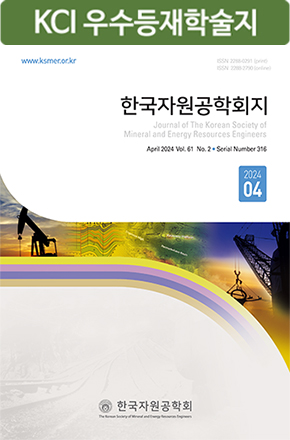- 최요순, 선우춘, 박형동, 2007, “대규모 노천광산의 운반 효율성 향상을 위한 덤프트럭의 최적 운반경로 분석,” 한국지구시스템공학회지, 제44권 6호, pp. 477-491.
- Aksoy, M. and Yalcin, E., 2000, “A computer program for open pit mine equipment selection: TruckMac,” In: Panagiotou, G.N. and Michalakopoulos, T.N. (eds), Mine Planning and Equipment Selection 2000, Balkema, Rotterdam, Netherlands, pp. 499-503.
- Alarie, S. and Gamache, M., 2002, “Overview of solution strategies used in truck dispatching systems for open pit mines,” International Journal of Surface Mining, Reclamation and Environment, Vol. 16, No. 1, pp. 59-76.
- Blackwell, G.H., 1999, “Estimation of large open pit haulage truck requirements,” CIM Bulletin, Vol. 92, No. 1028, pp. 143-149.
- Bonates, E.J.L., 1996, “Interactive truck haulage simulation program,” In: Hennies, W.T., Ayres Da Silva, L.A. and Chaves, A.P. (eds), Mine Planning and Equipment Selection 1996, Balkema, Rotterdam, Netherlands, pp. 51-57.
- Cardu, M., Sacerdote, I., Magro, A. and Crosa, M., 2004, “Analysis of possible alternatives for the exploration and hauling system in a marl mine (Tavernola BG, Italy),” In: Hardygora, M., Paszkowska, G. and Sikora, M. (eds), Mine Planning and Equipment Selection 2004, Taylor & Francis Group, London, UK, pp. 543-551.
- Choi, Y. and Nieto, A., 2011, “Optimal haulage routing of off-road dump trucks in construction and mining sites using Google Earth and a modified least-cost path algorithm,” Automation in Construction, in-press, http://dx.doi.org/10.1016/j.autcon.2011.03.015.
- Choi, Y., Park, H.D., Sunwoo, C. and Clarke, K.C., 2009, “Multi-criteria evaluation and least-cost path analysis for optimal haulage routing of dump trucks in large scale open-pit mines,” International Journal of Geographical Information Science, Vol. 23, No. 12, pp. 1541-1567.
- Ercelebi, S.G. and Bascetin, A., 2009, “Optimization of shovel-truck system for surface mining,” The Journal of the Southern African Institute of Mining and Metallurgy, Vol. 109, pp. 433-439.
- Hauck, R.F., 1979, “Computer-controlled truck dispatching in open-pit mines,” In: Weiss, A. (eds), Computer Methods for the 80’s in the Mineral Industry, Society of Mining Engineers of the American Institute of Minning, Metallurgical, and Petroleum Engineers, New York, USA, pp. 735-742.
- Hays, R.M., 1990, “Truck,” In: Kennedy, B. A. (eds), Surface Mining, Society for Mining, Metallurgy, and Exploration, Littleton, USA, pp. 672-691.
- Krause, A. and Musingwini, C. 2007, “Modelling open pit shovel-truck systems using the machine repair model,” The Journal of the Southern African Institute of Mining and Metallurgy, Vol. 107, pp. 469-476.
- Newman, A.M., Rubio, E., Caro, R., Weintraub, A. and Eurek, K., 2010, “A review of operations research in mine planning,” Interfaces, Vol. 40, No. 3, pp. 222-245.
- Niemann-Delius, C. and Fedurek, B., 2004, “Computer-aided simulation of loading and transport in medium and small scale surface mines,” In: Hardygora, M., Paszkowska, G. and Sikora, M. (eds), Mine Planning and Equipment Selection 2004, Taylor & Francis Group, London, UK, pp. 579-584.
- Oraee, K. and Asi, B., 2004, “Fuzzy model for truck allocation in surface mines,” In: Hardygora, M., Paszkowska, G. and Sikora, M. (eds), Mine Planning and Equipment Selection 2004, Taylor & Francis Group, London, UK, pp. 585-591.
- Osanloo, M., Gholamnejad, J. and Karimi, B., 2008, “Longterm open pit mine production planning: A review of models and algorithms,” International Journal of Mining, Reclamation and Environment, Vol 22, No. 1, pp. 3-35.
- Sturgul, J.R., 2000, Mine Design: Examples using Simulation, Society for Mining, Metallurgy, and Exploration, Littleton, USA, pp. 7-32.
- Suboleski, S.C., 1975, Mine Systems Engineering Lecture Notes, The Pennsylvania State University, University Park, Pennsylvania, USA.
- Temeng, V.A., 1997, A Computerized Model for Truck Dispatching in Open Pit Mines, PhD dissertation, Michigan Technological University, Michigan, USA.
- Topuz, E. and Duan, C., 1989, “A survey of operations research applications in the mining industry,” CIM Bulletin, Vol. 82, No. 925, pp. 48-40.
- Yan, S. and Lai, W., 2007, “An optimal scheduling model for ready mixed concrete supply with overtime considerations,” Automation in Construction, Vol. 16, No. 6, pp. 734-744.
- Zhang, H., 2008, “Multi-objective simulation-optimization for earthmoving operations,” Automation in Construction, Vol. 18, No. 1, pp. 79-86.
- Publisher :The Korean Society of Mineral and Energy Resources Engineers
- Publisher(Ko) :한국자원공학회
- Journal Title :Journal of the Korean Society for Geosystem Engineering
- Journal Title(Ko) :한국지구시스템공학회지
- Volume : 48
- No :4
- Pages :448-459


 Journal of the Korean Society of Mineral and Energy Resources Engineers
Journal of the Korean Society of Mineral and Energy Resources Engineers







